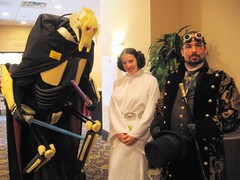Speaker: Sarah Houghton-Jan
It’s important to invest in staff training to build staff skills and morale, in addition to improving customer service. It takes time and money, which are not often plentiful. Evaluate where you are and what you need to get to where you want to be: planning & brainstorming to creation to assessment to training to reassessment to planning & brainstorming, etc.
What does your staff need to know how to do with technology to do their jobs well? Using competencies creates equitable expectations for all staff, reveals training needs, accurate job descriptions, helps with performance evaluations, consistent customer service, and helps staff adjust and handle change. Work with your staff to brainstorm on what they want to learn, and be sure to reassure them that they don’t need to know everything right now.
Work with a well-represented taskforce to create competencies and get management buy-in. Oh, and don’t call them competencies! Call them technology skills or anything else with less negative connotations. Break competencies out by categories, and be sure to include a “staying current” category. Best practices: keep it core & task-based, be aware of the different needs of different positions, include competencies in job descriptions, and revise frequently as new technologies are adopted in your library.
Online survey tools are the easiest way to assess competencies, but take care with how the results are presented so that there is less of a negative impact. Self-assessment is best. Review the assessments to track trends and then work with supervisors to create training lists for specific employees.
Training techniques will be determined based on topic and need, and there are plenty of resources out there to help with that. Just make sure you have the budget to do whatever you decide to do. People like rewards, as was noted in this morning’s keynote, so include that in your training budget.
Reassess on a regular basis, and include rewards and consequences to be effective. Celebrate the success of your staff!
Speakers: Maurice Coleman & Annette Gaskins
They are at a public library system with a very diverse population. The library staff wanted to have a technology fair/petting zoo, and there was enough buy-in from administration and the resources to do it. Time was the most crucial factor in planning for this. The topics were picked based on the tools that public service staff would use on a regular basis, as well as hot 2.0 topics that attract patron participation.
If you are planning to do several sessions in one day, make sure you have plenty of trainers so that no one gets burnt out. Also, have people available to direct people traffic. Make sure the facilities you use are sufficient to meet the needs of the training and the attendees.
I found it difficult to find take-away things from this presentation. Houghton-Jan went over the concepts behind the process, and I was hoping that Coleman & Gaskins could go into the applied aspect, which they did, but at such a detailed level that I couldn’t find many things relevant to my own library. Most of what they had to say were basic event planning tips, which are useful, but not what I came into the session expecting to get. Maybe I should have read the description in more detail.

